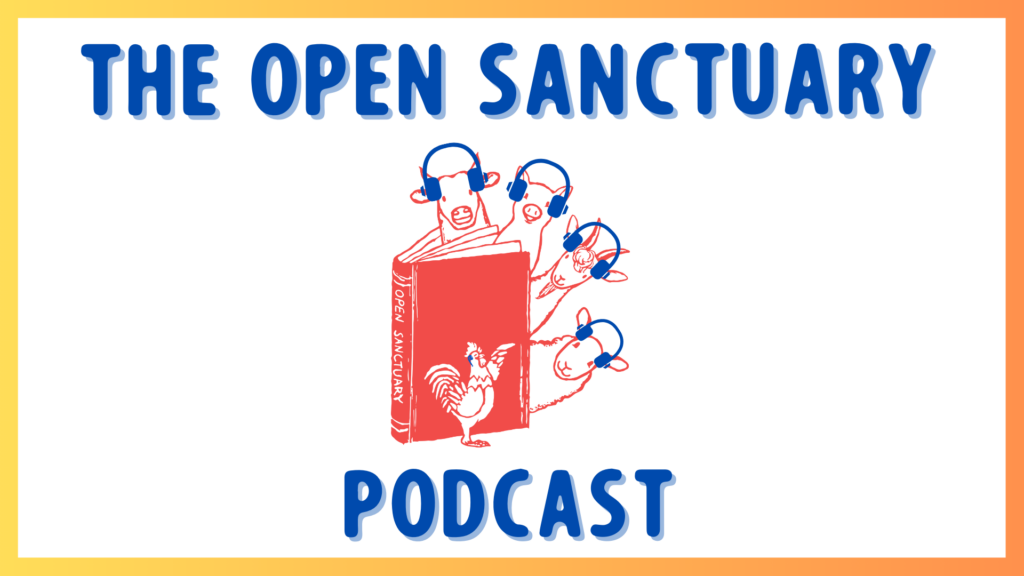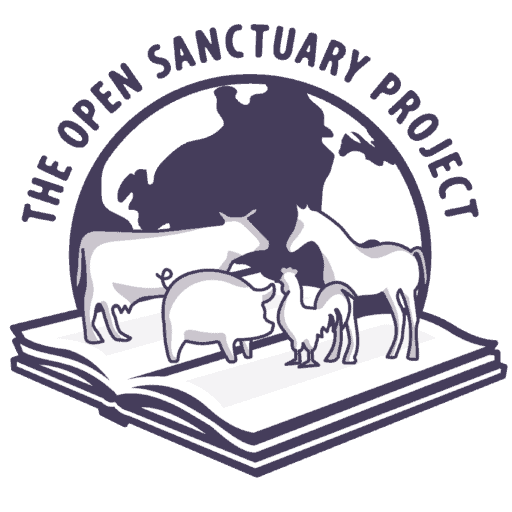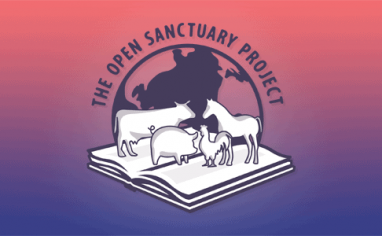
Subscribe To The Open Sanctuary Podcast
If you’d like to get the latest episodes of The Open Sanctuary Podcast, you can subscribe for free on all Podcast platforms, including Apple Podcasts and Spotify!
Episode Notes
Community Education Specialist Andie and Senior Advisor Tara discuss some helpful strategies and tips on how your animal organization can thoughtfully approach and respond to common visitor questions that sanctuaries get asked by visitors.
—
This Episode’s Referenced Open Sanctuary Project Resources:
- A Starter Guide to Common Questions Your Sanctuary Gets Asked and How to Thoughtfully Answer Them
- Fostering Critical Thinking at Your Animal Sanctuary
- Fostering Empathy Towards Farmed Animals
- Understanding Biases that Can Negatively Impact Farmed Animals and How to Help Folks Overcome Them
- The Importance Of Language Choices At Your Animal Sanctuary
- Communicating With Youth About Animal Exploitation
- An Introduction to Educational Programs and Opportunities Well-suited for Microsanctuaries
- In-Person Sanctuary Educational Programming: What Are Your Options?
- An Introduction To Fostering Agency In Farmed Animals At Your Animal Sanctuary
Episode Transcript (Auto-GeneratedThe following content was transcribed through an automated process and may contain transcription errors or misspellings.)
Tara Hess: Hey there friends, and welcome back to another episode of the Open Sanctuary Podcast. I’m Tara, the senior adviser here at the Open Sanctuary Project, and I’m here with Andie Springirth, our community education specialist. Andie has some great thoughts on how to approach and respond to common questions that sanctuaries get asked by visitors. So, if you’re a sanctuary educator or volunteer who’s looking to pick up some helpful tips on answering those questions that always seem to come up, then this episode is for you. So, Andie, what are the most common questions sanctuary educators get asked from visitors?
Andie Springirth: That’s a really good question, Tara. Many of the seasoned sanctuary folks who are listening right now are probably already saying some of those questions out loud to themselves. And for folks who are new to this realm, you will likely encounter them very soon. But the most common questions that farmed animal sanctuaryAn animal sanctuary that primarily cares for rescued animals that were farmed by humans. educators tend to get typically fall into one of six categories, which are sanctuary care and management practices or related to this topic, related to meat or animal flesh, eggs, other animal derived products, veganismA movement and way of living that seeks to eliminate the exploitation of and cruelty to nonhuman animals as much as possible. Often, veganism is defined synonymously with a plant-based diet, although veganism includes abstaining from elements of animal exploitation in non-food instances when possible and practicable as well., and plants. And in my personal experience, these are questions like, “Other animals eat other animals. Why can’t we eat animals, too?” “Haven’t we evolved to eat meat?” “What about humane meat?” “What about backyard chickenThe raising of chickens primarily for the consumption of their eggs and/or flesh, typically in a non-agricultural environment. eggs?” “You have so much space. Why don’t you rescue more animals?” And of course, “How can I start my own sanctuary?” and so on and so forth.
Tara Hess: So, you talk about the importance of preparation as a key component of effective education and outreachAn activity or campaign to share information with the public or a specific group. Typically used in reference to an organization’s efforts to share their mission., and you wrote an entire resource on how sanctuary educators can prepare for some of these common questions in advance by thoughtfully considering how to respond to them. In your opinion, why is it so important to prepare our responses to these questions in advance as much as we can?
Andie Springirth: That’s a really good question. Generally speaking, we want to prepare for these questions as much in advance so that we can ensure our responses are as aligned as possible with what our sanctuaries are trying to accomplish. Right? This is your missionThe stated goals and activities of an organization. An animal sanctuary’s mission is commonly focused on objectives such as animal rescue and public advocacy.. Your mission and of course your vision are always your compass. But more broadly, as sanctuary educators and representatives, one of the best parts of our jobs is the ongoing opportunity to facilitate experiences and provide knowledge to sanctuary visitors that allow them to deepen their understanding and widen their circles of compassion for farmed animalsA species or specific breed of animal that is raised by humans for the use of their bodies or what comes from their bodies.. And a lot of sanctuary folks often refer to these moments or these opportunities as light bulb moments. And as educators, we’re often the lucky ones who get to see that light bulb moment go off, that, “Oh, what’s happening to farmed animals is wrong.” And that’s an incredibly motivating and uplifting thing to experience. But we have to get folks there first. And it doesn’t just come naturally to those people. So, anyone who has been doing this or even if you’ve just started, you probably have already discovered that it can take a lot of effort, a lot of patience and empathy, and of course, a lot of very thoughtful dialogue and discussion. And as an educator, that’s really where you come in. So, preparing in advance as much as possible really sets you up for a greater chance of success in terms of getting people where you’d like them to go in your programming.
Tara Hess: Right. That makes sense. So, in your resource, you go over 40 common questions that sanctuary educators typically get, as well as thoughtful ways they can consider responding to them. Do you have any other helpful preparation tips for responding to common visitor questions?
Andie Springirth: Yes, I definitely do. First, I’d just like to point out that the broader categories, the six categories I defined a few minutes ago, are probably not super surprising for a lot of our listeners, especially when we think about our work and the spaces we’re typically working in. But the questions and answers can and should likely vary depending on your sanctuary’s specific context and mission, philosophy of care, background, the size, audience, location, etc. So, one helpful tip I’d like to give our listeners is to identify your own question patterns at your sanctuary so that you can anticipate how you and your staff would like to address and respond to its most common questions that it gets as effectively as possible. So, write them down. Write those questions down as you witness them and listen to them over time and then critically reflect on them and ask yourself what ways can you respond to them that feel most aligned with your mission and your staff’s particular capabilities. And of course, if there are questions that you get or your staff get that you all are potentially not really comfortable answering, think about how you might guide folks; anticipate this ahead of time, how you might guide folks to a compassionate source that can respond to them in a way that also aligns with your mission. And also, I just want to say that there certainly is not a one-size-fits-all way to have these types of discussions with sanctuary visitors, but there is another tip I’d love to offer folks. As sanctuary educators, we are often surrounded by our fellow animal liberationA social movement dedicated to the freeing of nonhuman animals from exploitation and harm caused by humans. allies. So, it can be quite easy to slip into the mindset that adopting your particular environments or your sanctuary’s ethics like veganism is an easy undertaking. And that’s because your community has likely built a really wonderful alternative way of being in relationship with farmed animals that is not based on exploitationExploitation is characterized by the abuse of a position of physical, psychological, emotional, social, or economic vulnerability to obtain agreement from someone (e.g., humans and nonhuman animals) or something (e.g, land and water) that is unable to reasonably refuse an offer or demand. It is also characterized by excessive self gain at the expense of something or someone else’s labor, well-being, and/or existence..
Andie Springirth: And in our sanctuary spaces, this becomes the norm, which is beautiful. And it’s definitely something to celebrate and encourage and share with the world. But it is really important to remember that while you are facilitating sanctuary education programs, interacting with the public, and of course in the context of what we’re talking about right now, answering those same visitor questions over and over again, to remember that transforming one’s relationship with farmed animals can actually be pretty hard for a lot of folks outside of the sanctuary setting. You probably have, or if you’re new, you probably will receive some resistance from visitors when responding to some of the common questions you get. And this can feel really frustrating at times, but this is just a reminder for folks to remember again that outside of a sanctuary setting, folks are saturated with ideas like speciesismA form of discrimination based on species membership; the belief that different species of animals deserve different ethical considerations regardless of whether they have similar needs or interests. and also white supremacist social structures like capitalism and patriarchy and colonialism, ableism, and all of those systems that marginalize a lot of people. So, depending on their background, their economic possibilities, their physical and mental capabilities, current circumstances, and so on, transforming their relationship with animals can be really challenging and even create an uneven playing field when it comes to accessibility to things like veganism. So, with this in mind, I think it’s also important for sanctuary educators to regularly ask themselves how their educational programming and their visitor programs, and specifically, their responses to these common visitor questions can become more supportive spaces that provide the kind of community dialogue and even enrichment that folks need to transform their relationship with farmed animals in a positive way and maintain a compassionate way of life. And one of the most important ways we can do this is by cultivating patience in our sanctuary spaces. I mentioned this word briefly a little earlier, but remaining patient with our program participants, our visitors, even our fellow advocates and ourselves, it does not require us to excuse or justify oppression or oppressive patterns.
Andie Springirth: But it just reminds us that unlearning those patterns is a healing process that can take a long time. So, rather than drawing on shame and guilt, qualities like patience asks us as educators to draw on compassion and care when we’re facilitating our programs and responding to these kinds of common questions. And I just want to say that with things like this, these qualities like this, skills like patience by our side, we really do get to witness and be a part of some really incredibly transformative individual and collective experiences. Those lovely light bulb moments that we all really enjoy.
Tara Hess: So speaking of patience and getting the same questions over and over again. Earlier, you mentioned a few of the specific questions you got asked a lot as a sanctuary educator, and I’m sure many folks listening have gotten similar questions, and they might be wondering what makes the responses you’ve offered in your resource particularly thoughtful. Could you say a little bit more about your recommended responses to those questions?
Andie Springirth: Absolutely. Yes. If you are operating a sanctuary for farmed animals, your organization will likely get asked a lot of questions about animal derived products like animal flesh, or more commonly referred to as meat. So, one of the very common questions a lot of educators get that I mentioned earlier is, “If other animals eat other animals, why can’t we humans eat other animals too? Haven’t we evolved to eat meat?” So, as a sanctuary educator, one of the first very helpful things you can do in order to effectively respond to a question like this is to critically reflect on it yourself and break it down, and then respond in a way that actually guides the visitor through the critical reflection process themselves. So for example, based on this particular question that I just mentioned as a sanctuary educator, you can ask yourself, “What assumptions or biases is this person coming in with, or might this person be coming in with if that’s what they’re asking you?” And then of course, asking yourself, “Are these assumptions accurate? Are they based in well-grounded research?” And related to this specific question in part, actually, yes.
Andie Springirth: Humans likely did evolve to eat meat. However, we also know, and this is where we check the accuracy of this person’s assumptions with them, in conversation with them, that based on our well-grounded research, despite having eaten other animals for thousands of years and there being research to suggest that our ancestors began eating other animals because it enabled them to consume more calories with less effort, which in turn may have led to these evolutionary changes in our bodies and brains that make us the modern human beings we are today, none of this information, however, means that animal consumption is biologically necessary for the vast majority of humans today. So, in many cases, we know that a healthy plant-based dietA diet that abstains from all animal products, including milk and eggs. A plant-based diet is synonymous with “strict vegetarianism”, and is the dietary component of someone practicing veganism. Those following a plant-based diet may or may not also choose to avoid non-food animal products or avenues of animal exploitation. can provide the proper amount of nutrition that our bodies need in order to thrive. Of course, in contrast, most other animals who kill other animals for food do need to consume them out of biological necessity in order to survive. So, the question for many of us humans becomes not whether we can eat other animals, but whether we should eat them. And that last question that you pose to the visitor who asked that question, the original question to you, that’s the final phase in the critical reflection process. That’s you guiding your visitors to make a more informed decision based on the well-grounded research that you have just provided them in your space. So to summarize my point here, is that to go back to your original question, what makes the thoughtfully crafted responses in the resource we have on our website so unique or so thoughtful, is that thoughtful responses to these kinds of questions should one of course be aligned with your mission. But two, they should also be empathetic. Remember that you are a facilitator. You are a guide for these folks. And three, importantly, they should nurture critical reflection that allows folks to get to where you want them to go from a place of compassion. And of course, importantly, well-grounded research. So, I hope that gives our listeners a better understanding of what I mean when I say thoughtful responses.
Andie Springirth: Going back to that thought I had a few minutes ago too. Thoughtful responses and discussions lead to more and more of those light bulb moments that we want more of.
Tara Hess: That was really helpful to hear you talk through that process. So, I’m sure that’s going to be helpful to folks. So, thank you so much for sharing all this with our audience today. For our listeners, we hope this episode has been helpful to you and your sanctuary. And if you’d like to read the resource that this podcast was inspired by, which will give you much more information. The way Andie just broke down that one question, we’ve got 40 more that you can go to and get a really detailed explanation of a response that you might consider for your sanctuary. So, to get to that resource, you can check out our show notes or you can go to www.opensanctuary.org and just type “common questions” in the search bar. And then we’ll also have some other helpful educational resources in the show notes which can help guide your education and outreach staff efforts as well. So, we hope you’ll check those out and thank you, Andie, for all your thoughtful insight and thanks to everyone listening. Until next time. Bye, friends.

Got A Podcast Idea? Contact Us!
If you have a topic or question you’d love to hear our staff address on The Open Sanctuary Podcast, please get in touch via our contact form!








